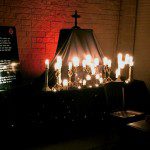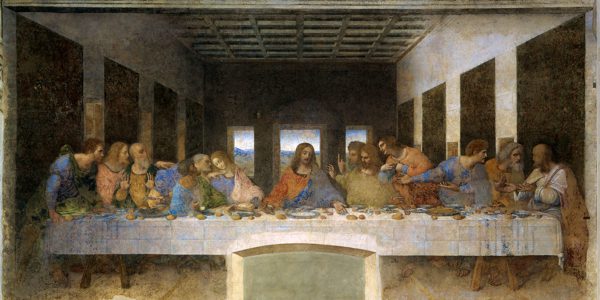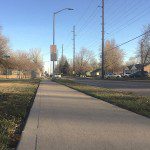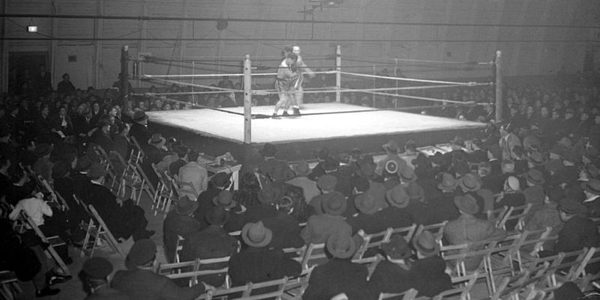 Every year on Maundy Thursday I wake up thinking about this painting. I’ve never seen it in person (bucket list), but I’ve known about it nearly my entire life. A copy of it was framed and hung in the second and third-grade Sunday School room in the tiny little Southern Baptist Church my family attended. When I was too bored or distracted to pay attention to the lesson I’d stare at this picture. It fascinates me to this day.
Every year on Maundy Thursday I wake up thinking about this painting. I’ve never seen it in person (bucket list), but I’ve known about it nearly my entire life. A copy of it was framed and hung in the second and third-grade Sunday School room in the tiny little Southern Baptist Church my family attended. When I was too bored or distracted to pay attention to the lesson I’d stare at this picture. It fascinates me to this day.
Maundy Thursday is rooted in Jesus’s teaching from John 13, “A new command I give you: Love one another. As I have loved you, so you must love one another. By this everyone will know that you are my disciples, if you love one another.”
In Jerome’s Latin Vulgate bible, the word for this new command is mandato… same word from which we get mandate. It’s also thought to be the origins of the name Maundy. There is a new mandate signified two ways in the four gospels: the redefinition of the Passover meal as Eucharist, and the washing of feet as a symbol of how the new community works.
I’ll think about this picture all day long, and stare at it from time to time. That we have this work at all is amazing. It’s the Thor of murals… you can’t kill it.
Da Vinci was an eccentric, notoriously slow and distracted. Legend has it that when his patron and the monastery pressured him to finish the mural, he threatened to use the abbot’s face as a model for the face of Judas. (You can’t rush fine art).
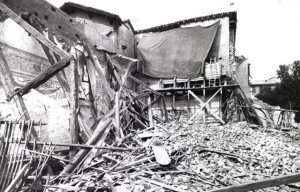 Begun in 1495, the methodology Da Vinci for the painting was an experiment that didn’t work and the painting deteriorated quickly. 150 years later, it was considered to be beyond saving. In 1776 this part of the abbey was used as a stable for French soldiers’ horses. Twenty four years later it was damaged in a flood that covered the entire wall. During WWII (1943) the monastery was destroyed. But the painting had been protected by a series of scaffolds and sandbags, and it emerged without a scratch. The Monastery was rebuilt around the painting, which is still in a dining hall. There are no other works of art in the room, and no written literature about it.
Begun in 1495, the methodology Da Vinci for the painting was an experiment that didn’t work and the painting deteriorated quickly. 150 years later, it was considered to be beyond saving. In 1776 this part of the abbey was used as a stable for French soldiers’ horses. Twenty four years later it was damaged in a flood that covered the entire wall. During WWII (1943) the monastery was destroyed. But the painting had been protected by a series of scaffolds and sandbags, and it emerged without a scratch. The Monastery was rebuilt around the painting, which is still in a dining hall. There are no other works of art in the room, and no written literature about it.
Here are just a few bits of trivia in the form of a quiz & answers… see how many out of the ten you get right.
10 Facts about DaVinci’s Last Supper:
- Why did DaVinci choose this subject matter for his painting?
- How big is it?
- Where is the painting located?
- How long did it take and when was it finished?
- Who is Jesus sharing a meal with in this picture?
- Can you name those seated at the table from left to right?
- Why is the painting in such poor condition?
- Why can we not see Jesus’s feet?
- What year was the painting’s major restoration completed?
- What is DaVinci’s most famous painting?
Answers:
- The work was commissioned by the Duke of Milan (Lodovico Sforza), and the subject matter was chosen for DaVinci.
- 15 feet tall by 29 feet wide.
- The original mural is on a wall of the refectory (dining hall) in the Convent of Santa Maria delle Grazie in Milan, Italy.
- It took DaVinci (a noted procrastinator with a history of leaving works unfinished), about three years to complete the mural from 1495 to 1498.
- They are the 12 disciples.
- Bartholomew, James, Andrew, Judas, Peter, John, Jesus, Thomas, James (brother of John), Phillip, Matthew, Thaddeus, and Simon.
- The painting is in such poor condition because instead of painting in wet plaster, DaVinci chose to paint this on dry plaster. The immediate result was a much more stunning piece. The long term disaster was that it was not at all durable. It was not unlike painting on a cement wall with Tempura paint.
- Jesus did originally have feet, but in 1650 another door was added to the refectory and so the portion of the painting beneath Jesus (nobody knew how famous it would eventually be), was literally demolished. What you see there is an old doorway.
- 1999.
- Mona Lisa.



